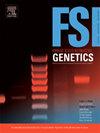Forensic investigative genetic genealogy using genotypes generated or imputed from transcriptomes
IF 3.1
2区 医学
Q2 GENETICS & HEREDITY
引用次数: 0
Abstract
The utility of transcriptome analysis in forensic genetics is steadily increasing. The transcriptome, with its ability to reflect both transcript levels and their nucleotide sequences, is proving to be useful for a variety of different applications, including body fluid identification and donor assignment, thereby providing both genetic and contextual information. Furthermore, the substantial single nucleotide polymorphism (SNP) coverage obtainable with whole transcriptome sequencing may prove useful for additional applications. In this study, we expand the current knowledge of transcriptomics in forensic genetics by showing how RNA can be used for forensic investigative genetic genealogy (FIGG) purposes and inference of distant relationships. Genetic data was simulated for relationships ranging from full siblings (first-degree relatives) to third cousins (seventh-degree relatives). The sets of SNP genotypes were subsequently reduced to only include observed and imputed SNP genotypes at loci covered by transcriptome sequencing of whole blood. The relationships of relatives as distant as second cousins could be reliably classified based on an average of 99,548 SNPs. Appropriate thresholds for sequence quality parameters limited the rate of erroneous genotype calls, with the remaining errors proving to have little to no effect on relationship inference. In conclusion, we present a proof-of-concept study on how transcriptome-based genotypes, in combination with imputed genotypes, may be used for reliable relationship inference for FIGG purposes.
使用从转录组产生或输入的基因型的法医调查遗传谱系
转录组分析在法医遗传学中的应用正在稳步增加。转录组具有反映转录水平及其核苷酸序列的能力,被证明可用于各种不同的应用,包括体液鉴定和供体分配,从而提供遗传和背景信息。此外,全转录组测序可获得的大量单核苷酸多态性(SNP)覆盖范围可能被证明对其他应用有用。在这项研究中,我们通过展示RNA如何用于法医调查遗传谱系(FIGG)目的和推断远亲关系,扩展了法医遗传学转录组学的现有知识。遗传数据模拟了从全兄妹(一级亲属)到三堂兄弟(第七级亲属)的关系。SNP基因型组随后减少到仅包括全血转录组测序覆盖的位点上观察到的和输入的SNP基因型。根据平均99548个snp,远房亲戚之间的关系可以可靠地分类。适当的序列质量参数阈值限制了错误基因型调用的比率,其余错误被证明对关系推断几乎没有影响。总之,我们提出了一项概念验证研究,即基于转录组的基因型如何与输入的基因型相结合,可用于FIGG目的的可靠关系推断。
本文章由计算机程序翻译,如有差异,请以英文原文为准。
求助全文
约1分钟内获得全文
求助全文
来源期刊
CiteScore
7.50
自引率
32.30%
发文量
132
审稿时长
11.3 weeks
期刊介绍:
Forensic Science International: Genetics is the premier journal in the field of Forensic Genetics. This branch of Forensic Science can be defined as the application of genetics to human and non-human material (in the sense of a science with the purpose of studying inherited characteristics for the analysis of inter- and intra-specific variations in populations) for the resolution of legal conflicts.
The scope of the journal includes:
Forensic applications of human polymorphism.
Testing of paternity and other family relationships, immigration cases, typing of biological stains and tissues from criminal casework, identification of human remains by DNA testing methodologies.
Description of human polymorphisms of forensic interest, with special interest in DNA polymorphisms.
Autosomal DNA polymorphisms, mini- and microsatellites (or short tandem repeats, STRs), single nucleotide polymorphisms (SNPs), X and Y chromosome polymorphisms, mtDNA polymorphisms, and any other type of DNA variation with potential forensic applications.
Non-human DNA polymorphisms for crime scene investigation.
Population genetics of human polymorphisms of forensic interest.
Population data, especially from DNA polymorphisms of interest for the solution of forensic problems.
DNA typing methodologies and strategies.
Biostatistical methods in forensic genetics.
Evaluation of DNA evidence in forensic problems (such as paternity or immigration cases, criminal casework, identification), classical and new statistical approaches.
Standards in forensic genetics.
Recommendations of regulatory bodies concerning methods, markers, interpretation or strategies or proposals for procedural or technical standards.
Quality control.
Quality control and quality assurance strategies, proficiency testing for DNA typing methodologies.
Criminal DNA databases.
Technical, legal and statistical issues.
General ethical and legal issues related to forensic genetics.

 求助内容:
求助内容: 应助结果提醒方式:
应助结果提醒方式:


